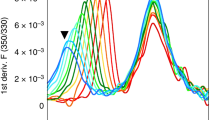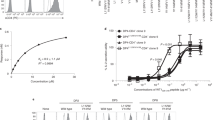Abstract
HUMAN histocompatibility (HLA) antigens are expressed on the surfaces of almost all cell types and according to various criteria are integral membrane glycoproteins1. They are composed of equimolar amounts of two dissimilar polypeptide chains which are non-covalently linked and which have molecular weights of about 43,000 and 12,000 as judged by polyacrylamide gel electrophoresis in sodium dodecyl sulphate (SDS)2–4. The larger chain carries the polymorphic allogeneic specificities and all of the carbohydrate2. The smaller chain represents β2-microglobulin, whose amino acid sequence shows marked homology to the CH3-domain of the γ-1 chain of immunoglobulin G (ref. 5). This homology and other arguments have led to the proposals that HLA antigens and immunoglobulins have a common evolutionary origin6,7, and that HLA antigens have an immunoglobulin-like structure in which two basic units of one each of the larger and smaller polypeptide chains are linked either non-covalently8 or by a disulphide bridge9,10 to give a 4-chain dimer of molecular weight 110,000. In contrast to the latter proposal, some results presented here suggest that HLA antigens do not have a dimeric structure.
This is a preview of subscription content, access via your institution
Access options
Subscribe to this journal
Receive 51 print issues and online access
$199.00 per year
only $3.90 per issue
Buy this article
- Purchase on Springer Link
- Instant access to full article PDF
Prices may be subject to local taxes which are calculated during checkout
Similar content being viewed by others
References
Snary, D., Goodfellow, P., Hayman, M. J., Bodmer, W. F., and Crumpton, M. J., Nature, 247, 457–461 (1974).
Cresswell, P., Turner, M. J., and Strominger, J. L., Proc. natn. Acad. Sci. U.S.A., 70, 1603–1607 (1973).
Springer, T. A., Strominger, J. L., and Mann, D., Proc. natn. Acad. Sci. U.S.A., 71, 1539–1543 (1974).
Tanigaki, N., and Pressman, D., Transplant. Rev., 21, 15–34 (1974).
Cunningham, B. A., and Berggard, I., Transplant. Rev., 21, 3–14 (1974).
Bodmer, W. F., Nature, 237, 139–145 (1972).
Gally, J. A., and Edelman, G. M., A. Rev. Genet., 6, 1–46 (1972).
Rask, L., Ostberg, L., Lindblom, B., Fernstedt, Y., and Peterson, P. A., Transplant. Rev., 21, 85–105 (1974).
Strominger, J. L., et al., Transplant. Rev., 21, 126–143 (1974).
Cresswell, P., and Dawson, J. R., J. Immun., 114, 523–525 (1975).
Bodmer, W., Tripp, M., and Bodmer, J., in Histocompatibility Testing 1967 (edit. by Curtoni, E. S., Mattiuz, P. L., and Tosi, R. M.), 341–350 (Munksgaard, Copenhagen, 1967).
Allan, D., and Crumpton, M. J., Biochem. J., 120, 133–143 (1970).
Siegel, L. M., and Monty, K. J., Biochim. biophys. Acta, 112, 346–362 (1966).
Andrews, P., Meth. biochem. Analysis, 18, 1–53 (1970).
Birk, Y., Gertler, A., and Khalef, S., Biochem. J., 87, 281–284 (1963).
Hellsing, K., Biochem. J., 114, 145–149 (1969).
de Lorenzo, F., Goldberger, R. F., Steers, E., Givol, D., and Anfinsen, C. B., J. biol. Chem., 241, 1562–1567 (1966).
Spatz, L., and Strittmatter, P., J. biol. Chem., 248, 793–799 (1973).
Robinson, N. C., and Tanford, C., Biochemistry, 14, 369–378 (1975).
Helenius, A., and Simons, K., Biochim. biophys. Acta, 415, 29–80 (1975).
Schwartz, B. D., Kato, K., Cullen, S. E., and Nathenson, S. G., Biochemistry, 12, 2157–2164 (1973).
Perutz, M. F., Eur. J. Biochem., 8, 455–466 (1969).
Author information
Authors and Affiliations
Rights and permissions
About this article
Cite this article
SNARY, D., GOODFELLOW, P., BODMER, W. et al. Evidence against a dimeric structure for membrane-bound HLA antigens. Nature 258, 240–242 (1975). https://doi.org/10.1038/258240a0
Received:
Accepted:
Issue Date:
DOI: https://doi.org/10.1038/258240a0
This article is cited by
-
The CD2 antigen associates with the T-cell antigen receptor CD3 antigen complex on the surface of human T lymphocytes
Nature (1989)
-
Functional sites of human class I MHC molecules: Paradigms a dozen?
Immunologic Research (1987)
-
Incorporation of murine MHC antigens into liposomes and their effect in the secondary mixed lymphocyte reaction
Nature (1978)
-
Isolation and N-terminal amino acid sequence of membrane-bound human HLA-A and HLA-B antigens
Nature (1976)
-
Products of the major histocompatibility complex and their relationship to the immune response
Nature (1976)
Comments
By submitting a comment you agree to abide by our Terms and Community Guidelines. If you find something abusive or that does not comply with our terms or guidelines please flag it as inappropriate.



